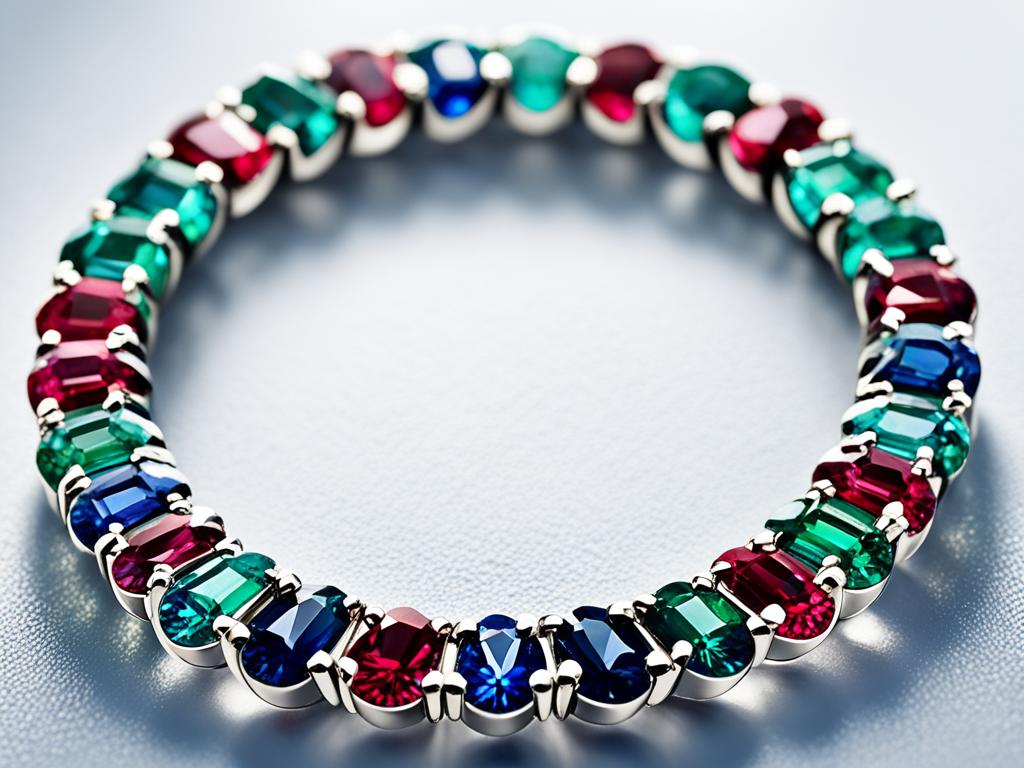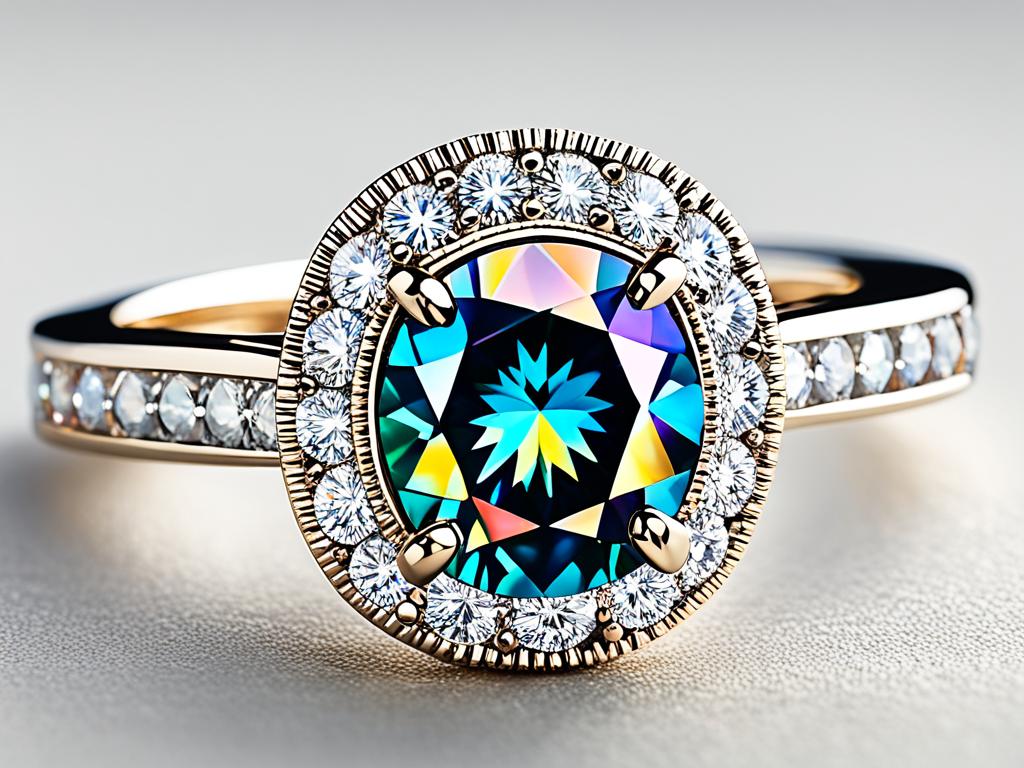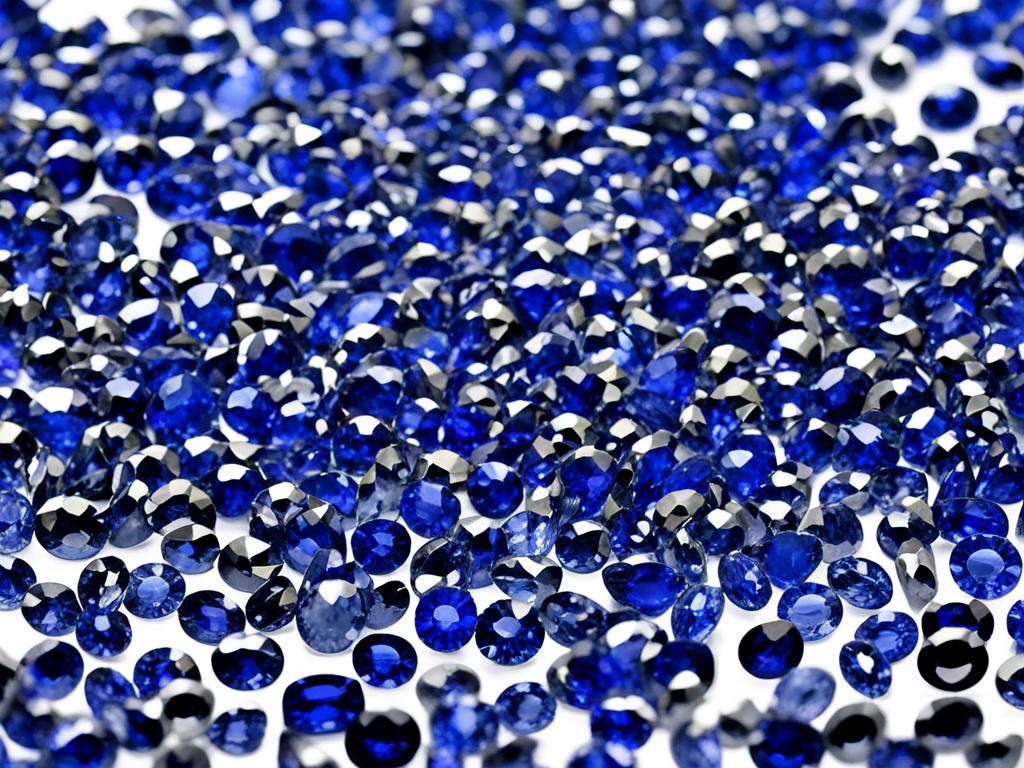Gemstones are valuable minerals found in rocks. They are chosen for their beauty, rarity, and durability. Suitable ones are carefully cut and polished for jewelry. Most gemstones go through this process, but organics like pearls, corals, and ambers are exceptions. They are formed by living creatures and occur naturally. More than 300 different gemstones are used in jewelry. Among them, a few are very popular.
Gemstones are rated based on their durability and wearability. This is done by looking at their hardness on the Mohs scale. Diamonds are the toughest, scoring a 10. A stone’s hardness matters a lot. It shows how well it will hold up over time. For example, diamonds are great for daily wear. But pearls need more gentle care.
Key Takeaways
- There are over 300 different gemstones used in jewelry, each with unique properties and characteristics.
- Diamonds are the hardest naturally occurring substance, ranking 10 on the Mohs scale, making them ideal for daily wear.
- Softer gemstones like pearls require more cautious handling due to their lower Mohs hardness score.
- Gemstone hardness is a crucial factor in determining a stone’s durability and suitability for jewelry.
- Precious stones like diamonds, rubies, sapphires, and emeralds are highly valued for their rarity and beauty.
Introduction to Gemstones
Definition of Gemstones
Gemstones sparkle brightly in the world of rocks. These shining minerals are found deep within the earth. They’re chosen for their stunning beauty, rarity, and strong durability. After being unearthed, they go through a process. This process makes them perfect for sparkling in jewelry. Most gemstones go through this journey to reach our collections.
Yet, some stones take a different road. Stones like pearls, corals, and ambers are from life around us. These are the organics. Even though they come from living sources, they still shine beautifully.
Significance and Allure of Gemstones
For centuries, gemstones have symbolized peace and wealth. Owning these precious stones meant being in a higher social class. They shimmer with captivating beauty and vibrant colors. This makes them not only beautiful but also very valuable.
Classification of Gemstones
Gemstones fall into two main groups: precious stones and semi-precious stones. Precious stones stand out for their beauty, hardness, and rarity. They are more expensive than semi-precious stones. Diamond, emerald, ruby, and sapphire are the four types of precious stones.
Precious Stones
The four precious stones have outstanding features. For example, diamonds are the hardest known substance, scoring 10 on the Mohs scale. Emeralds, from the beryl family, rank 7.5 to 8 on the Mohs scale and are found globally. Rubies, with a Mohs scale rating of 9, mainly come from places like Burma and Thailand. Sapphires, also Mohs 9, are from regions such as Sri Lanka, Thailand, and Australia.
Semi-Precious Stones
Semi-precious stones, while natural, lack the top qualities of precious stones. There are over 130 kinds, like amethyst, topaz, lapis lazuli, quartz, and peridot. These stones are still great for jewelry, with various hardness levels such as Alexandrite’s 8.5, Amethyst’s 7, and Aquamarine’s 7.5 to 8.

Gemstones: Types, Properties, and Uses in Jewelry
Gemstones are diverse, each with special traits and roles in jewelry. Diamonds, the hardest known mineral, are perfect for daily wear like in engagement rings. Rubies and sapphires are highly durable too, making them popular choices.
Emeralds, with their vibrant green, are part of the beryl group. They’re a bit softer than diamonds but still quite durable. Pearls, ambers, and corals come from plants or animals and are loved for their soft look in necklaces. Other stones like aquamarines, citrines, and amethysts provide a variety of colors for affordable jewelry.
| Gemstone | Mohs Hardness | Unique Properties | Jewelry Applications |
|---|---|---|---|
| Diamond | 10 | Hardest natural substance | Engagement rings, daily wear |
| Ruby | 9 | Vibrant red color, durability | Fine jewelry, statement pieces |
| Sapphire | 9 | Wide color range, durability | Engagement rings, fine jewelry |
| Emerald | 8 | Distinct green hue, brittleness | Necklaces, earrings, rings |
| Pearl | 2.5-4 | Soft luster, organic formation | Necklaces, earrings, bracelets |
| Aquamarine | 7.5-8 | Blue-green hues, durability | Everyday jewelry, engagement rings |
| Citrine | 7 | Bright yellow color, durability | Affordable jewelry, statement pieces |
| Amethyst | 7 | Vibrant purple hues, affordability | Jewelry, home decor, and more |
Diamond: The Ultimate Gemstone
Diamonds rank as the hardest natural material, at 10 on the Mohs scale. They are pure carbon gems formed deep within Earth’s mantle over ages. Because of their sparkling, clear, and long-lasting diamond properties and diamond characteristics, they are perfect for rings and fine jewelry.
Origin and Formation
Diamonds’ birth is truly awe-inspiring. They develop when carbon-rich stuff experiences extreme heat and pressure far under the Earth. This process takes billions of years, leading to the creation of these precious gems.
Properties and Characteristics
A diamond’s value shines through its cut, color, clarity, and size. Colorless, flawless ones are the rarest and costliest. Their ability to endure wear and their symbolism of love and luxury position them as top choices, too.
Applications in Jewelry
Diamonds serve a wide range of diamond jewelry applications. Their unmatched sparkle and toughness make them great for rings, celebrating lasting love every day. They’re also found in various other jewelry types, adding everlasting value and charm.

Rubies: The King of Gemstones
Rubies are red corundum gemstones, coming in at number 9 on the Mohs hardness scale. They are just behind diamonds, which are the hardest. Their intense ruby color varies from bright red to deep crimson, described as “pigeon’s blood red.” This color range highlights the gem’s beauty.
These gems are also found in shades like brownish-red, purplish-red, and dark red. This diversity adds to their unique allure.
Rubies are not only beautiful but also very tough, perfect for daily wear. Although big, flawless rubies are scarce and pricey, their durability is a plus. It means they’re less likely to scratch or get damaged. This durability has made rubies one of the world’s most prized gemstones for centuries.
Sapphires: Captivating Hues
Sapphires are part of the mineral corundum family, so they’re related to rubies. They’re known well for their blue shades, but they also come in yellow, pink, white, and even rare orange and green tones. What color you see in a sapphire depends on tiny elements in the corundum. Rare, deep-hued Fancy colored sapphires are quite valuable.
Color Variations
Scoring 9 on the Mohs scale, sapphires are tough enough for every day. Yet finding a perfect, flawless sapphire is rare, pushing up their cost. Because of their stunning color choices, sapphires are loved for engagement rings and high-end jewelry.
Rarity and Value
Though blue sapphires are famous, other colors are gaining popularity. Color variations from pink to purple provide plenty of options. Collectors prize these rare sapphires in unique colors, making them more valuable than standard blue ones.

Emeralds: The Symbol of Elegance
Emeralds are from the beryl mineral group. They are known for their amazing emerald green hue. This green can be bright or deep, ranging from vivid tones to darker ones. The color comes from chromium and vanadium, making emeralds highly prized.
Flaws and Inclusions
Emeralds often have many internal flaws and inclusions. These flaws are part of their natural beauty. Although finding a flawless emerald is very rare and costly, their imperfections don’t lessen their appeal.
Symbolism and Meaning
In many societies, emeralds are seen as symbols of symbolism. They stand for fertility, rebirth, and wisdom. The green color is believed to have a soothing effect, adding to the gem’s popularity in jewelry.
Pearls: Nature’s Exquisite Gems
Pearls are special because they form inside some shelled mollusks, like oysters. Layers of nacre build around a grain of sand or another small object. This creates a pearl over time. There are many pearl types, such as freshwater, Akoya, South Sea, and Tahitian, each unique.
Formation and Types
It takes saltwater pearls between six months to four years to grow. Only one in 10,000 mollusks in the wild actually produces a pearl. Natural pearls are indeed very rare. Freshwater pearls vary in size from 5mm to 13mm, while Akoya pearls are typically 6mm to 8mm. Tahitian pearls can get as large as 20mm. Yet, their usual size falls between 9mm and 11mm. South Sea pearls are mostly 7mm to 8mm in diameter, making larger pearls very scarce.
Luster and Quality Grading
Akoya pearls stand out for their brilliant pearl luster, making them quite valuable. The golden hue on South Sea pearls adds to this value. Pearls come in many colors like white, pink, blue, and black. They are perfect for every occasion and can be passed down as family treasures. The nacre’s smooth layers determine a pearl’s luster. Pearls are judged by their shine, size, shape, and surface. Pearls are unique because they don’t require cutting or polishing. Their natural radiance makes exquisite jewelry pieces, such as necklaces and earrings.
Aquamarine: The Ocean’s Treasure
Aquamarines are cousins to emeralds, both part of the beryl family. They have shades of blue like the ocean. These colors vary from light, ice-like tones to deep Mediterranean blues. The darker and bluer aquamarines are the prized ones.
On the Mohs scale, aquamarines score a 7.5-8, showing they are tough. This makes them great for wearing every day. They are also clear and bright, making them perfect for many kinds of jewelry. From rings to pendants, aquamarines add a calm, soothing touch. The gem gets its name from the Latin words for “water” and “sea.”
Amethyst: The Mystical Gemstone
Amethyst is part of the quartz family, famous for its beautiful amethyst purple hues. They come in shades from light lavender to deep red-purple. The color depends on how much iron is in the quartz. In the past, amethysts were hard to find and very costly. But, new discoveries have made them easier to get and more affordable. Even so, they’re still loved for their special look.
Vibrant Purple Hues
The amethyst purple hues are truly eye-catching. They range from light lilac to deep, rich purple. The richest, red-purple amethysts are the most valuable. These colors come from a lot of iron in the quartz.
Symbolism and Lore
Amethysts are known for more than just looks. They have many spiritual meanings and stories. The Greek name for amethyst means “not intoxicated.” This is because people thought the stone could stop drunkenness.
Amethysts are also tied to spiritual and mental growth. They’re said to help with calming, healing, and intuition. That’s why they’re often used in spiritual practices and jewelry.
Gemstone Jewelry Design and Craftsmanship
The heart of gemstone jewelry lies in the hands of designers and craftspeople. They add their skill and art to these precious stones. You see, every gemstone is not just placed, it’s chosen for each piece’s unique shine. Whether it’s for a ring, a necklace, or earrings, the goal is to bring out the best in every gem.
Master jewelers work their magic next. They cut and polish the gemstones with care. Then, they secure them in their setting, creating a lovely piece of jewelry. This process really shows off the gem’s beauty while highlighting the maker’s skill.
Whether they’re setting a diamond in a ring or weaving wire for a special pendant, the effort is clear. The designs show the hard work and skill of those who make them. They turn these gemstones into something truly magnificent, full of beauty and grace.
Source Links
- https://www.gabrielny.com/blog/different-gemstones-used-in-jewelry/
- https://www.relojeriaalemana.com/en/editorial/classics/types-gemstones-jewellery/
- https://medium.com/@uk-crystal-wholesale/the-ultimate-guide-to-gemstones-types-meanings-and-uses-of-precious-stones-f5be729f36d5
- https://www.ashidiamonds.com/Education/GemstoneGuide/Intro_Gemstones.aspx
- https://en.wikipedia.org/wiki/Gemstone
- https://www.ashidiamonds.com/Education/GemstoneGuide/Typesof_Gemstone.aspx
- https://www.gemsociety.org/article/how-gems-are-classified/
- https://www.gemsociety.org/gemstone-encyclopedia/
- https://www.britannica.com/topic/diamond-gemstone
- https://www.firemountaingems.com/learn/categories/essential-resources/gemstone-meanings/diamond-gemstone-meanings.html
- https://store.museumofjewelry.com/blogs/news/ruby-the-king-of-precious-stone
- https://www.gemstones.com/gemopedia/ruby
- https://www.starlanka.com/gemstone-education/sapphire-stone/
- https://rauantiques.com/blogs/canvases-carats-and-curiosities/a-rainbow-of-sapphire-rings
- https://www.thenaturalsapphirecompany.com/education/sapphires-101/medicinal-properties-sapphires/
- https://emeralds.com/education/symbolism-of-emeralds/
- https://www.gemsociety.org/article/history-legend-emerald-gems-yore/
- https://www.beadsofcambay.com/blogs/meaning/emerald-meaning-healing-properties-benefits-and-uses
- https://www.thepearlsource.com/blog/facts-about-pearls/what-is-a-pearl/
- https://medium.com/@truegemstone2023/pearl-gemstone-verview-1a9b52895cd4
- https://www.gemrockauctions.com/learn/a-z-of-gemstones/pearl
- https://www.firemountaingems.com/learn/categories/essential-resources/gemstone-meanings/aquamarine-gemstone-meanings.html
- https://moonmagic.com/blogs/news/aquamarine-meaning
- https://www.dwsjewellery.com/blog/amethyst/
- https://www.gemrockauctions.com/learn/a-z-of-gemstones/amethyst-stone-information
- https://nendine.com/how-is-gemstone-jewelry-manufactured/
- https://beadaholique.com/blogs/techniques-guides/gemstone-meanings-metaphysical-properties
- https://www.vummidi.com/blog/types-of-jewellery-stones/


